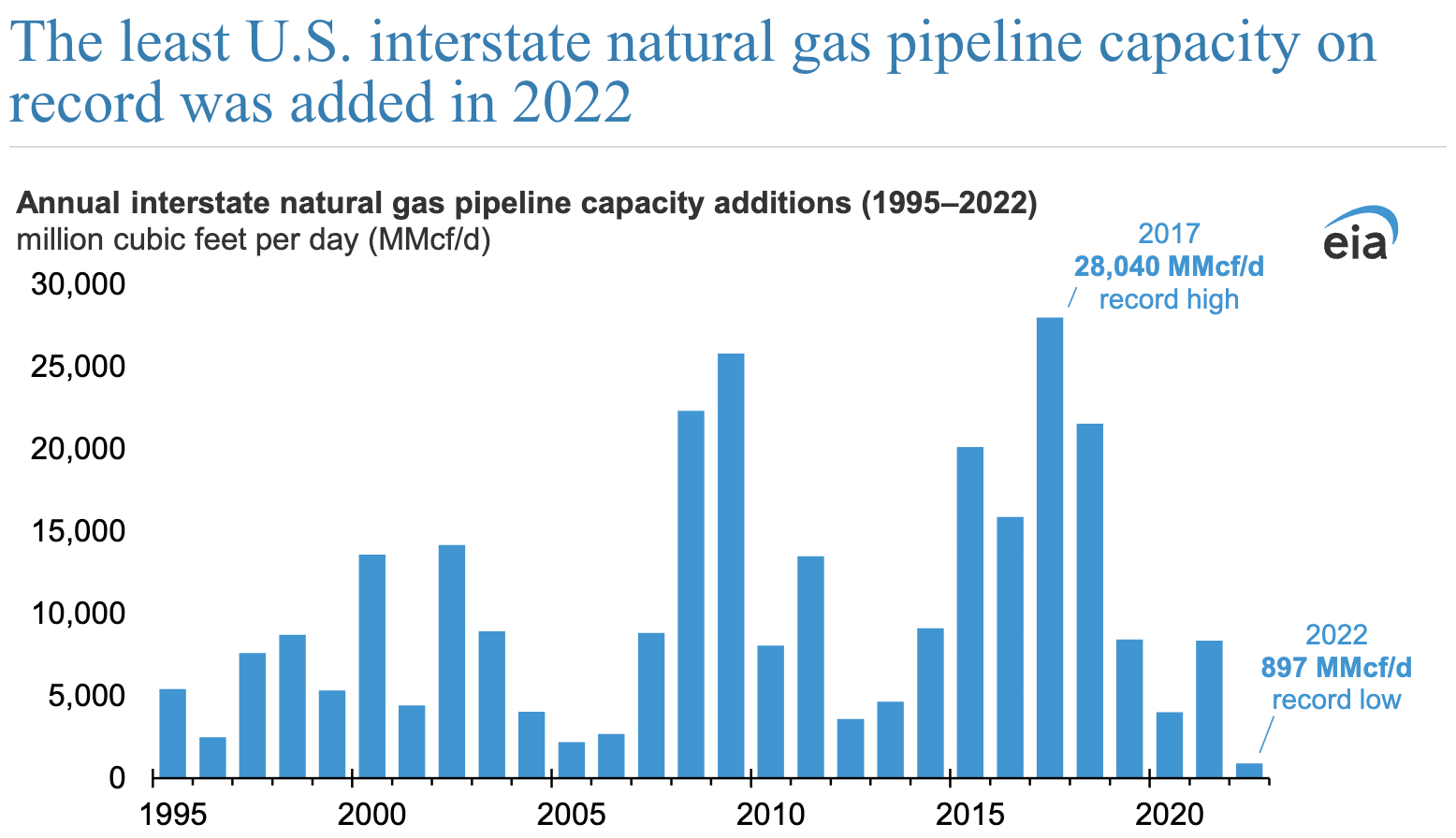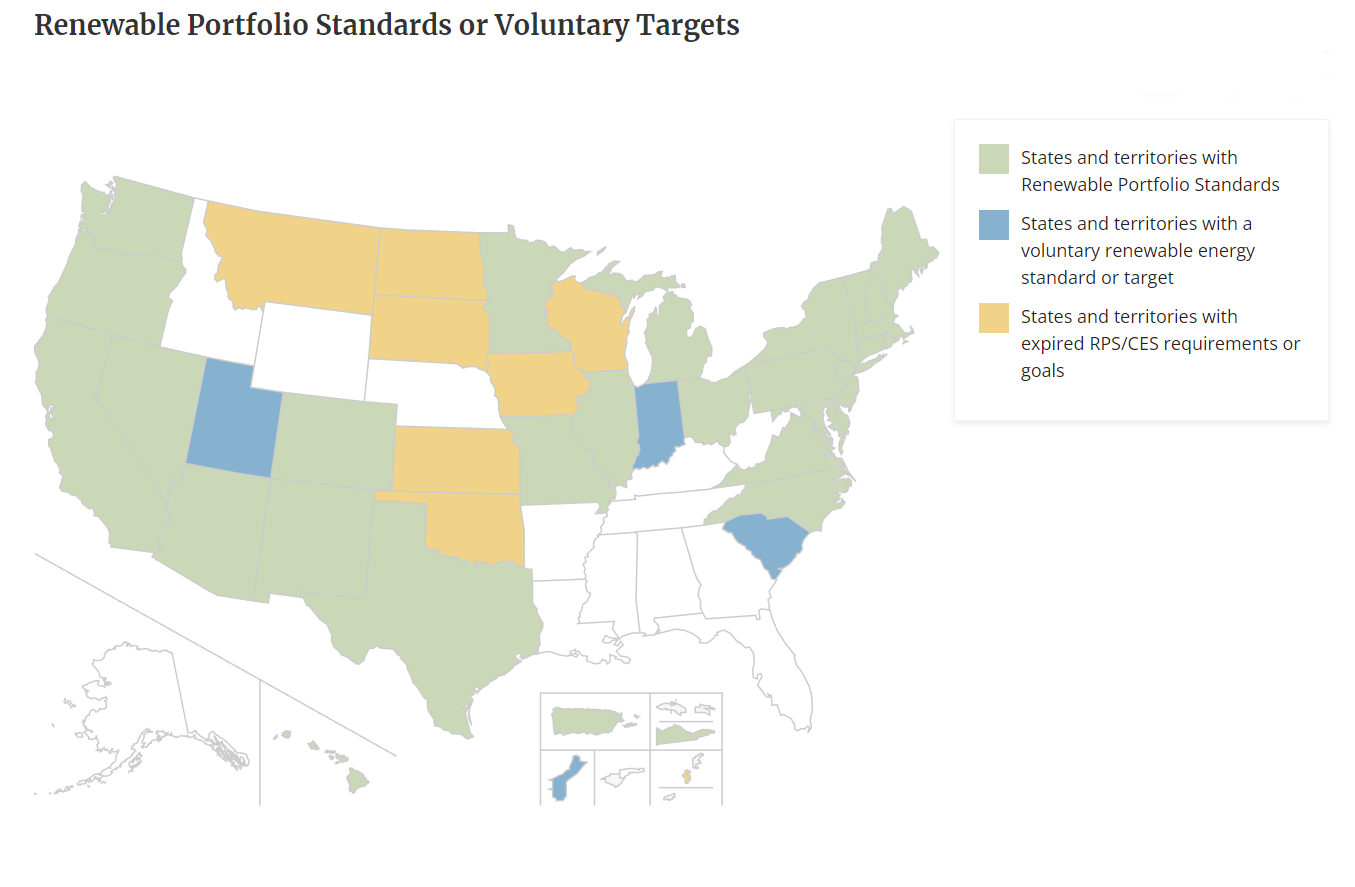The Energy Information Administration (EIA) reported that interstate natural gas pipeline capacity additions reached a record low in 2022 based on data collected since 1995. In 2022, 897 million cubic feet per day of interstate natural gas pipeline capacity was added from five projects, according to EIA’s latest State-to-State Capacity Tracker, which contains information on the capacity of natural gas pipelines that cross state and international borders. The five projects that increased interstate natural gas capacity in 2022 focused primarily on upgrading compressor stations, with only one project adding a relatively small amount of new pipe. As natural gas is our cleanest hydrocarbon and the United States has it in abundance, this represents a historic impediment to future economic growth.
The 2022 gas pipeline capacity additions are just 3 percent of the record amount added (28,040 million cubic feet per day) in 2017. Since the Federal Energy Regulatory Commission (FERC) has to approve new interstate natural gas pipeline capacity, the news speaks loudly regarding its motivations as does President Biden’s promise to cause the demise of the U.S. oil and gas industry stated during his campaign. Regulatory hurdles are clearly stymying growth in pipeline capacity and thus to natural gas production, which points to much-needed permitting reform for interstate pipelines.

EIA Report
EIA notes that capacity was added to intrastate pipelines and to existing FERC-administered interstate pipelines as expansions that increased intrastate capacity in 2022. Since 2017, about 70 percent of the growth in natural gas production came from the Permian and Haynesville regions, located near liquefied natural gas (LNG) export terminals along the Gulf Coast. In Texas and Louisiana, intrastate projects, rather than interstate projects, increased takeaway capacity and connected natural gas production to LNG export terminals.
Building large-scale, commercial natural gas pipelines that cross state boundaries involves a number of contractual, engineering, regulatory, and financial requirements that involve addition coordination and that take longer to complete compared with intrastate pipeline projects. Some of those interstate gas pipelines have been in the works for years but due to rising costs from permitting delays have had to cancel projects. One such project was the Atlantic Coast project, a pipeline from West Virginia to North Carolina along a route that had to pass through the Appalachian Trail in Virginia. In the summer of 2020, despite a major win on the right-of-way issue at the U.S. Supreme Court, the developers of the pipeline scrapped the project due to ongoing delays and major cost overruns.
Mountain Valley Pipeline
The 303-mile Mountain Valley pipeline was originally set for completion in 2018 and while it is now 94 percent complete, it is being stonewalled by activists in federal court. Permitting delays and court action have increased the pipeline’s cost from the original estimate of $3.5 billion to $6.6 billion. Recently, the pipeline received a positive report from the U.S. Fish and Wildlife Service that indicated 5 federally protected species of bats, fish and a plant would not likely to be jeopardized by the pipeline.
A ruling from the Fourth Circuit is expected soon in a lawsuit in which environmental groups are contesting a stream-crossing approval by the West Virginia Department of Environmental Protection and a similar approval by the Virginia Department of Environmental Quality that is expected by early summer. If all goes well, Equitrans Midstream Corp., the lead partner in the project, hopes to have the remaining work done in time for the pipeline to begin transporting natural gas by the end of this year, along a route that would take it from northern West Virginia, through Southwest Virginia, and connecting with an existing pipeline near the North Carolina line. This pipeline alone would add more than double the capacity of total U.S. interstate pipeline additions last year.
FERC’s Jurisdiction and Biden’s Edict
During the first days of his Presidency, President Biden embarked on his environmental goals to “end fossil fuels,” pushing FERC to consider changes to the way it reviews applications to approve and construct new natural gas infrastructure projects by addressing greenhouse gas emissions and environmental justice concerns in its decisions. Last year, FERC released a new certificate policy statement, which would govern the process for approving new natural gas infrastructure projects and an “interim” policy statement on how it would consider greenhouse gas emissions and climate change impacts from new natural gas infrastructure.
Originally, FERC intended to apply the policy statements to both pending and new applications, effective without a comment period or transition schedule. But, after receiving backlash from Congress, FERC changed its issuances to “draft” policy statements rather than “interim” policy statements, made the policy change apply only to new proposed projects, and held a comment period. The proposed revisions to the certificate policy statement are significant, having the potential to pause or stop the development of new projects and major expansions. There is no timeline by which FERC must act, leaving some developers to question the viability of new natural gas infrastructure projects. While the comment period has expired, FERC has not released final actions regarding the policy, so project decisions are in limbo.
New England Imports Natural Gas
The U.S. Northeast is importing LNG from foreign producers to meet its natural gas demand because of insufficient pipeline capacity to bring natural gas from neighboring Pennsylvania where the Marcellus basin holds large natural gas deposits. New York state has been particularly hard on pipeline construction under Governor Cuomo, and those policies have continued under Governor Hochul. Due to regulatory hurdles and lengthy court battles, pipeline companies have not built pipeline capacity needed in the region. Rather than add pipeline capacity, “band aid fixes” to New England’s gas supply such as suspending the Jones Act to temporarily ease receipt of more LNG imports and federal assistance in paying for New England consumers’ energy bills are being used by the Biden administration, which are not lasting or affordable solutions to addressing electric reliability concerns. Further, the Marcellus basin could be supplying LNG facilities with natural gas if the new interstate pipeline capacity could be built.
Conclusion
EIA data show that interstate pipeline capacity is being held hostage by regulatory hurdles and court proceedings as the least amount of interstate natural gas pipeline capacity was added in 2022 since data collection began in 1995. Lack of pipeline permitting reform has resulted in spiraling costs that resulted in pipeline cancellations. Those pipeline projects that persist have costs skyrocketing as can be seen by the Mountain Valley Pipeline’s costs almost doubling. President Biden wants the domestic oil and gas industry to be gone and is doing all his administration can to cause its demise, even pushing an independent agency that has control over interstate pipelines to do its bidding. If consumers use natural gas, they should be aware that there is a war against their fuel choice underway, which has the potential to radically alter their lives.
*This article was adapted from content originally published by the Institute for Energy Research.


